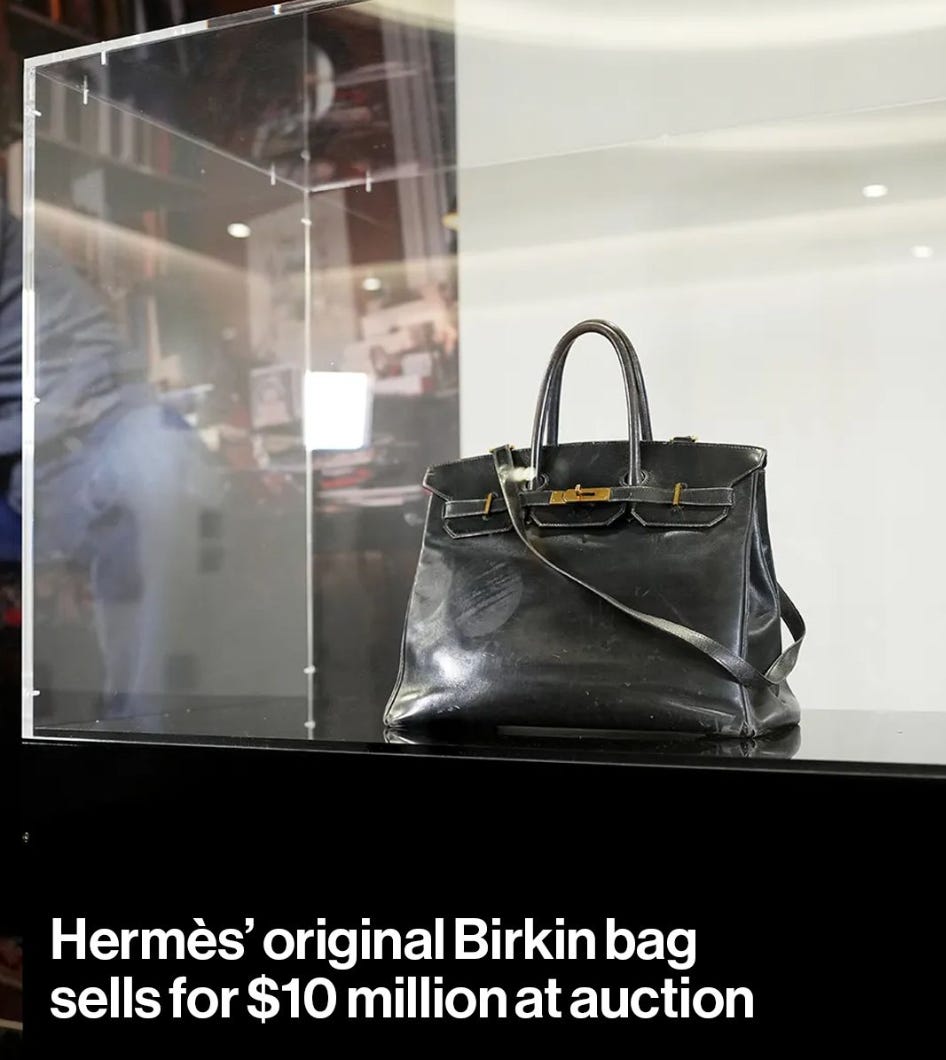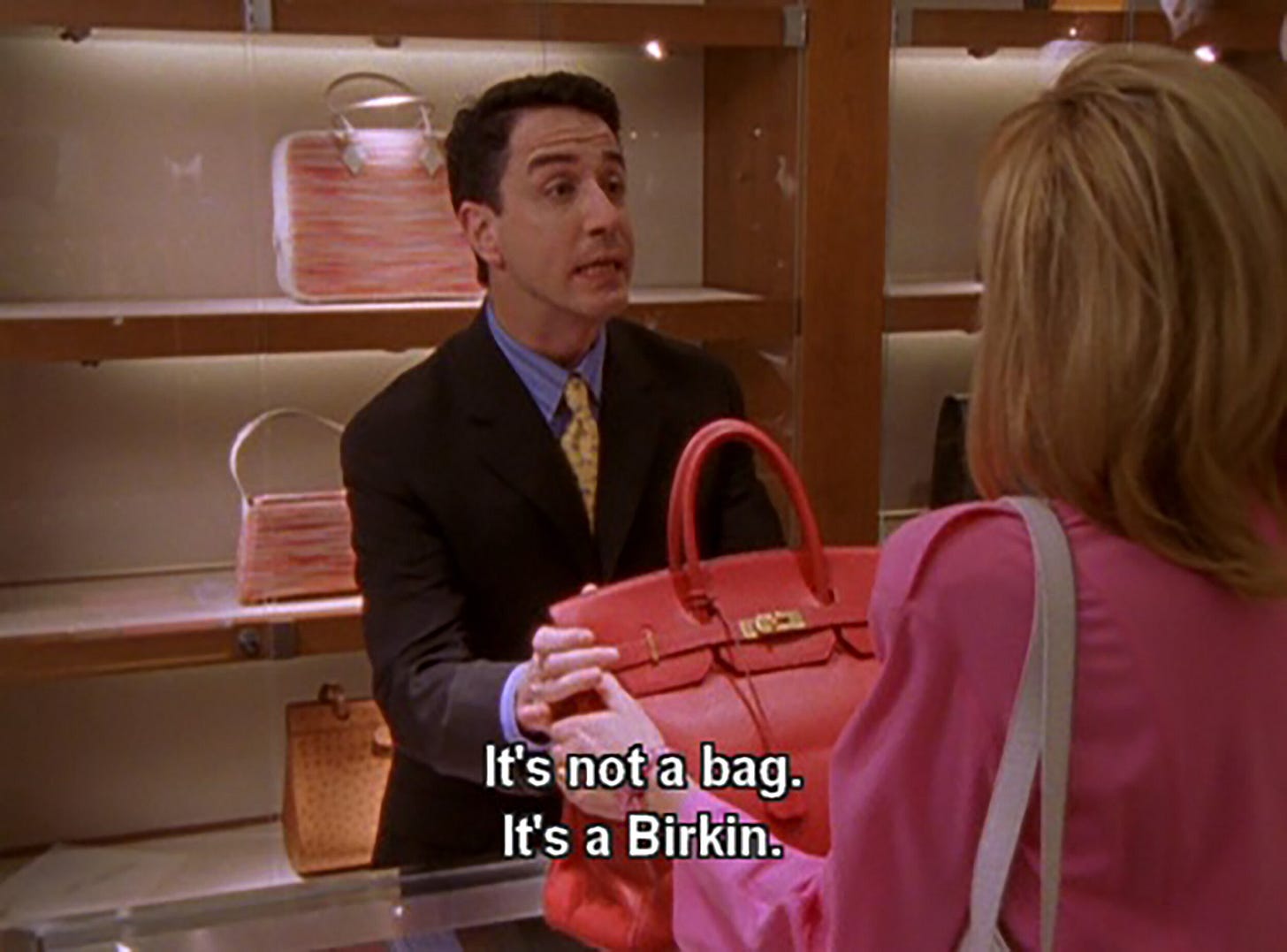How to Buy a Birkin Bag: A Lesson in Scarcity and Luxury
A handbag for half-a-million dollars? From a wicker basket to the the most coveted bag in the world. The journey of how Birkins became a true object of desire in the fashion world.
Salesperson: “It’s $4000”
Customer: “I know”
Salesperson (with a smile): “And there’s a waiting list”
Customer (smiles): “I assumed”
Salesperson : “5 years”
Customer (shocked): “For a bag?”
Salesperson : “it’s not a bag. It’s a Birkin!”
Introduction: The Mystique of the Birkin Bag
There are usually three camps of people when it comes to Birkin bags: Those that never heard of it, those that are familiar with it but think it’s overpriced, and then there are those that love the brand so much they refuse to acknowledge that the first group of people exist. So to enlighten those unfamiliar, before the Birkin bag, the french brand Hermès was already well-established as a house of luxury leather goods, catering to their elite clients’ needs. Today, of course, they are also the maker of the most coveted handbags on earth- the Birkin (and while some of us are still trying to pronounce Hèrmes correctly, let’s move on to what makes this product the topic of interest). Like most luxury products, the Birkin bag is loved by celebrities, impossibly difficult to source and commands a luxury price tag as well, but it’s the main character in this piece because it’s elevated it’s status to what many brands can only aspire to, i.e. being an item of true desire.
The Birkin, by any standard is a high-end product based on their price alone, as they can retail for anything in the range of $12000 to $20000 for a bag but when I say they are objects of desire, I mean that second-hand Birkin bags can actually sell for way more: $100000, with some going for up to half-a-million. While they have a reputation of master craftsmanship and quality, there is more to it than the sum of it’s inputs and that’s what makes it interesting for us.
But what psychological factors are at play here? Hermès has masterfully woven several behavioral principles into their strategy, keeping consumers not only wanting the bag but emotionally invested in the brand.
A fortuitous moment: The origins of the Birkin
While the tale has had a few variations, legend has it that fashion history changed on a late-night flight from Paris to London. In 1983, a serendipitous upgrade placed Jane Birkin (the English-French actress, singer, model and it girl) in first class. She was carrying her signature wicker basket to hold her personal essentials. As she placed her straw bag in the overhead compartment, all the contents spilled in front of the passenger next to her, including her Hermès diary. The other passenger assisted her as she scrambled to collect her things and he joked that she needed a handbag with pockets. The actress replied that the day Hermès made a large everyday bag that could hold all the items a busy mother carried, she would give up her signature oversized basket in its favor. The passenger so happened to be Jean-Louis Dumas, then the artistic director and CEO of Hermès. They chatted and by incorporating her feedback, Dumas drew the very first sketches of the Birkin bag on an airplane sickness bag. From humble(as humble as it gets for first-class) beginnings to Birkin bag history, the luxury handbag that would one day rule the world!

The Power of Scarcity: Wanting What You Can’t Have
At the heart of the Birkin’s allure is scarcity. The psychological principle of scarcity tells us that people place higher value on items that are less available. By limiting how many bags are produced and by controlling the process of how they’re sold, Hermès creates an atmosphere where the Birkin feels rare and hard to get, regardless of how many may actually exist.
We see this principle at work in many industries—limited-edition sneakers, exclusive cars, and even concert tickets—but Hermès takes it to the next level by offering Birkins not based on money alone but also on the relationship a customer has cultivated with the brand. Wanting what you can’t have is powerful, and Hermès makes sure the Birkin always feels just out of reach.
Curating an Experience: Why You Have to Earn the Birkin
Buying a Birkin is more like entering a secret club than purchasing a bag. Hermès has designed a shopping experience where earning the privilege to purchase is almost as important as the purchase itself. For many customers, it’s not just about the bag; it’s about the experience. You’re expected to build a relationship with the sales associates, buy other Hermès products, and cultivate your "status" with the brand before you may be “offered” a Birkin.
This experience of earning your way to a purchase plays into the idea of exclusivity. The Birkin isn't just a bag; it becomes a status symbol that you had to work for, making it feel that much more valuable. It's the same principle at work in exclusive clubs or memberships. So you’re not just paying for an item, but for the feeling that you’ve earned your place in a coveted inner circle.
Status Symbol: The Birkin as a Marker of Wealth and Success
In a world where appearance can communicate volumes, the Birkin functions as a clear status symbol. Owning one signals that you’re part of a rarefied group—those who have the money, taste, and connections to acquire this elusive luxury item (bare in mind, this is also subjective). This ties into the psychological principle of social proof. We often take cues from others about what we should value or aspire to, and seeing high-status individuals flaunt a Birkin reinforces its importance in the eyes of the public.
For many, the Birkin isn’t about practicality or even personal style—it’s about what the bag represents: a pinnacle of success. The bag acts as a badge to signal to others you’ve achieve this milestone. You see this mechanism used in non-luxury products as well, such as the language learning app Duolingo, in which you earn badges for maintaining your streak. With the Birkin, you signal a streak of being able to afford a number of high-end items, or in other words “wealth”. As a result, people are willing to pay astronomical prices and the secondary market can command astronomical prices because it’s a short cut to be part of the exclusive club without “earning” the right to it. All the benefits, none of the effort, provided you can afford it.
How Scarcity Drives Demand: The Luxury Brand Playbook
Hermès has mastered the use of scarcity to drive demand, a technique used across luxury brands. When something is rare, the fear of missing out kicks in, causing potential buyers to act more urgently. Hermès doesn’t saturate the market with Birkins. Instead, they produce a limited number of bags each year, ensuring that demand outstrips supply. Even celebrities and high-net-worth individuals aren’t guaranteed immediate access.
This playbook is used by other luxury brands too, but Hermès has perfected it by blending scarcity with status. Their customers feel special because getting a Birkin feels like an earned experience—one where they had to work to achieve it and despite what others may think, earned experiences hold more value in the eyes of the beholder.
When does it cross the line? Perception vs Deception
We need to consider another tactic in play: deception and perception. Hermès may use scarcity to help drive demand, but what it can’t be certain whether there really is a scarcity or just the perception of scarcity. Let’s consider perhaps the most well known luxury product, diamonds. It’s a common misconception that diamonds are rare, the truth is that it’s rare because those that control the supply do just that, control the supply. Just like how DeBeers controlled the supply to ensure the perception of scarcity, we cannot say for sure if the Birkin is scarce because Hermès controls the supply. This is not uncommon with many luxury brands such as Ferrari, or Rolex, etc. where waitlists are used. According to an interview with one Rolex dealer on a tiktok interview, the waitlist doesnt officially exist (or at least not in the way we think it does). It is a way to keep people on hold and encourage more spending on other products in the promise of then being allowed to get what they are truly after. It's the ultimate upsell in that it happens before they get the object they want.
No regrets!
Buying other products before buying the product you’re actually after works in the favour of luxury brands due to a principle known as the "sunk cost fallacy." This concept describes the tendency for people to continue investing in something (time, effort, money, etc.) because they've already invested in it, even when it might not be rational or beneficial to do so.
The basic idea is that once we commit resources (like money, time, or emotional energy) to a decision or a goal, we feel compelled to continue, even if new information suggests that stopping might be the better option. This is because we don't want to feel like our prior investments have been wasted.
In the context of luxury brands like Hermès or products like the Birkin bag, the sunk cost fallacy could manifest when customers continue purchasing lesser products or spending time building a relationship with the brand in hopes of eventually being offered a coveted item. The more they invest in the process, the more emotionally (and financially) committed they become, which heightens their desire for the final reward.
Taking it too far?
However, with all this exclusivity comes controversy. Hermès has faced criticism, and even lawsuits, over the way they tie the purchase of one product to another. In 2024, Hermès faced a class action lawsuit over antitrust charges by tying the sale of one item to the purchase of another. Essentially, customers are sometimes forced to buy other Hermès products—like scarves, belts, or lesser handbags—before they’re even considered for the elusive Birkin. This has sparked debate about whether Hermès’ practices are transparent and fair, especially as luxury buyers find themselves spending thousands without any guarantee they’ll ever get the item they truly want.
Conclusion: The Birkin as a Case Study in Luxury Branding
The Hermès Birkin bag is a perfect example of how a luxury brand can harness the power of scarcity, exclusivity, and social proof to create an object of desire. While it’s undoubtedly a well-crafted product, its true value lies in the psychological forces that drive its appeal. By controlling access to the Birkin, Hermès has turned it into more than just a bag—it’s a symbol of wealth, success, and exclusivity, making it one of the most coveted items in the world.
For anyone looking to create strong emotional ties between their brand and customers, the Birkin bag is a masterclass in how to use scarcity and personalization effectively. And as we’ve seen with other luxury brands, timing campaigns with real-world events or social interactions can amplify these effects, driving engagement and desire even further. But brands must tread carefully—using these principles thoughtlessly can backfire, especially when consumers feel they’re being manipulated into spending more without clear rewards.
If you enjoyed this article and found it insightful, please take a moment to share it with your network on social media! I enjoy writing these, but it does take time and effort to bring you each piece, so every share helps more people discover the content. If you don't want to miss out on more deep dives into the psychology behind brands and products taking the world by storm and how you can apply these in your life, subscribe to my newsletter on Substack, where you'll join a growing community of curious minds interested in how these principles shape our world.









